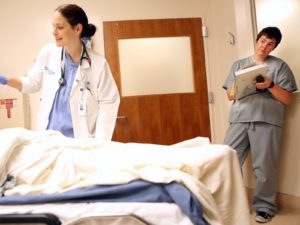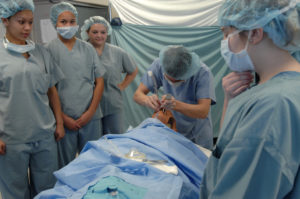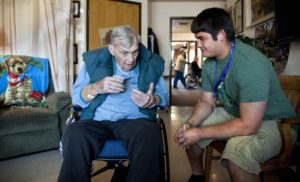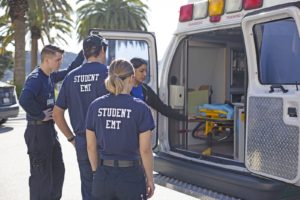Along the path to medical school, many students choose to pursue clinical experiences to complement their pre-medical schoolwork. From scribing to becoming a volunteer EMT, clinical experiences can come in all shapes and sizes, and finding the right experience can be as challenging as it is personally enriching.
In this article, we will explore the types of experiences that we think are worth your time and commitment.
Here at the University of Colorado, Denver School of Medicine, our Admissions Officers find that the most valuable clinical experiences are the ones that provide students a mature insight into the intricacies and challenges of effectively providing patient care. Selecting positions that allow pre-meds to offer sustained contributions to patient care—while also offering exposure to a wide-range of healthcare issues—hits the sweet-spot for a meaningful experience.
We recommend that students seek out experiences where they can meaningfully contribute as a member of a healthcare team. Whether it be serving as a caretaker or as an EMT on a transport unit, these types of experiences reflect an applicant who has committed to learning firsthand about patient care and is serious about building a career in healthcare, especially when these experiences are pursued over a long period of time.
(Note: clinical experiences of more than a year also inspire compelling answers to questions presented in secondary applications and during med school interviews!)
Let us now break down a few types of clinical experiences that we think are worthwhile.
1. Medical Scribing

As one of the most common clinical experiences seen by our Admissions Boards, scribing in an Emergency Room or inpatient hospital department allows a pre-med to take an active role in the healthcare process. This type of experience is seen frequently by our Admissions Officers, but it is the self-reflective pre-med student who can effectively convey how their time as a scribe has molded their understanding of the healthcare system and contributed to their desire to become a physician. Often, these positions are either voluntary or paid. Students follow the on-call physician into an exam room where they document patient information in the patient’s Electronic Medical Record (EMR). This lightens the administrative burden on the physician and teaches students common medical terminology.
Pros: Direct exposure to patient care—you are not a spectator! Become a functioning member of a medical team. Learn how to work collaboratively with care providers in a healthcare facility.
Cons: Time-intensive training (most paid scribing positions require at least 100 hours of training). No direct patient contact. Generally, not a ‘shadowing’ experience: students may not be able to ask physicians questions as they make their rounds. Very common on med school applications, so it behooves students to do some critical reflection about why this experience is meaningful for them as an individual.
2. Physician Shadowing

Most pre-med students have some degree of shadowing experience on their plate, and for good reason: shadowing is an excellent way of learning firsthand what a practicing physician actually does day-to-day. It requires minimal commitment on the part of a pre-med, so the amount of time spent shadowing is the key here. Selecting a physician(s) based on specialty and area of interest is important to develop a robust understanding of providing care.
Pros: Developing meaningful relationships with physicians. Exposure to a wide variety of health issues, depending on the specialty. Learn about the patient-physician interaction firsthand. This may also lead to an excellent Letter of Recommendation on your application!
Cons: No direct patient contact; purely observational. Unpaid. Must first build a network to locate a physician that will allow you to shadow. If you elect this type of experience over others, time spent alongside the physician is key: aim to build a long-standing commitment to shadowing one physician so that you may learn the intricacies of that specialty.
3. Volunteering at Healthcare Facility, Clinic, or Hospice

Whether at a hospice facility or in the community as an EMT, pre-meds can gain direct and impactful patient care experiences through their volunteerism. The scope of volunteering in these roles is vast, but common roles include: hospice volunteer assisting patients at the end of life; volunteer EMT positions at events and around the community; volunteer patient intake at a local clinic; or volunteering as a counselor or other service position with local nonprofits that work with underserved or high-risk communities. These types of experiences highlight the service-oriented aspect of many pre-med students.
Pro: Direct patient interaction. Exposure to a variety of medical conditions and demographic groups. Develop empathy for the patient experience.
Cons: Some roles require minimum time commitments and may have rigid volunteer scheduling and training requirements. Application cycles can mean waiting to begin volunteering until you’ve received the proper training—plan accordingly!
4. Paid Positions

Generating additional income while receiving invaluable clinical experiences is on many pre-med students’ radars, and our best advice to doing so involves receiving additional certifications. These types of positions are natural segues into becoming an entry-level healthcare provider and may require several months of initial certification training, but they are the most direct, hands-on clinical experiences a pre-med can find. Such certifications include: EMT-B, Medical Assistants, Emergency Room Technicians, Pharmacy Technicians, Phlebotomists, Licensed Practical Nurses, Certified Nurse Assistants, and Paramedics. These clinical experiences can also be pursued outside of the undergraduate environment, making them appealing during a gap year. Some roles are volunteer, others are paid.
Pros: Excellent direct patient care experience. Learn how to interact with patients and provide effective, empathetic care. Can complete additional coursework while in school or during a gap year. Relative ease of finding work: there are many job opportunities for licensed entry-level healthcare professionals.
Cons: Does not necessarily involve working directly with doctors as shadowing does. Cost and time associated with additional training to obtain license.
Want More Medical School Application Hacks? Sign Up Below to Receive Our Pre-health Newsletter!
